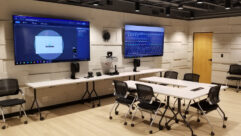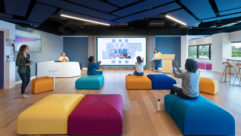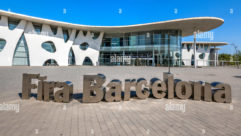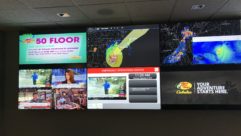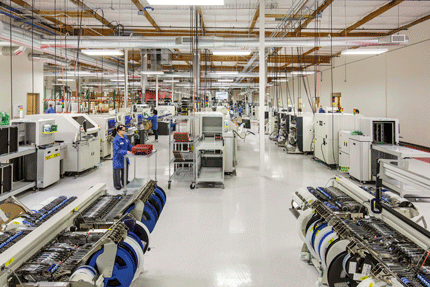

Biamp Systems invited me to Oregon last week to attend the ribbon-cutting ceremony for the company’s new Cascade Building in Tigard, a suburb of Portland. The facility is the new home to Biamp’s manufacturing and customer support teams, which have relocated from the company’s Gemini Building in nearby Beaverton.

President and CEO Steve Metzger offered some brief opening remarks, reminding attendees that this year marks Biamp’s fortieth anniversary, and praising the manufacturing and customer support staff for “doing everything necessary to put together the world’s best commercial audio and video products.”
He then turned over the microphone to COO Matt Czyzewski, observing, “This is really his building; this is his responsibility.”
“We have re-entrenched our efforts to continue manufacturing here in Oregon,” Matt said. “All of our products are made here in the United States,” he added, before leading the crowd outside for the opening ceremony, where City of Tigard Mayor John L. Cook had the privilege of cutting the ribbon.
The new 60,000-plus-square-foot building, which began operating in May, has allowed manufacturing to expand significantly, executive vice president of marketing Graeme Harrison told me. Biamp maintains additional engineering operations in Brisbane, Australia, and Rochester, New York, but chose to move manufacturing no further than a couple of miles from its headquarters so as not to inconvenience its staff, he said. The area vacated by manufacturing in the Gemini Building is being repurposed to provide additional space for training and meeting rooms and administrative offices.
The Cascade Building provides ample space for employee amenities such as a large lunch room, lounge, internet café and fitness room, as well as plenty of office space. But the bulk of the facility is, of course, dedicated to manufacturing, which has expanded to five production lines with the move.
With the ribbon-cutting completed, we split into groups of about a dozen each for a tour of the production area. My group followed manufacturing engineer Tyler Fife, who has been with the company since 2011.

“Biamp is the largest PCBA manufacturer by volume in Oregon and southwest Washington,” Fife reported. The material flows from the PCBA (printed circuit boards with assembled components), sheet metal and print shop lines are all deposited in what is referred to as the “supermarket,” he explained. “This is what we need to have on-hand to provide to our assembly area such that we can get it out the back door and meet our customer orders.”
There are three lines producing surface mount products, one of which is brand new for the Cascade Building. As Graeme Harrison explained to me later, the new SMT machine is capable of positioning 50,000 parts per hour, twice the quantity of the two older machines. Biamp’s very first SMT machine could handle just 1,200, he said.

Products are designated either standard or custom, the latter requiring customer-specific configuration of cards and other optional components. Turnaround is fast: “If it’s a standard product we will meet a customer order in one day. If it’s custom, we turn it around in three days,” said Tyler.
Quality assurance is everything, from beginning to end. Every component on every PCBA is checked for correct positioning and orientation; every finished unit is 100 percent tested. Further, every tiny component on the reels feeding the machines can be traced to the finished product, Tyler told us: “We know exactly where those parts are.”
Above each line, screens display hourly or daily progress via custom software. “It references back to our manufacturing software, Microsoft Dynamics AX. It pulls the data from there and summarizes it in whatever custom way we want. It’s been a big progression for us in the last two years,” he said.
Of course, problems sometimes arise. “As we try to perform to standards and meet all of our goals, when an issue arises that prevents us from meeting our goals we create an improvement action,” said Tyler. “They get assigned to the support team to go investigate and drive to a root-cause corrective action.”

The tour over, I spent some time with Graeme, who led me over to a giant flowchart on the wall that traces the progress of each product from conception to shipping. As he noted, Biamp is very open about all of its methods and procedures; nothing was hidden from view on the tour, and the flowchart is a permanent fixture on the wall.
Biamp follows the design thinking methodology, a process that came to prominence in the late 1960s and early seventies. As executed by the company, it’s a four-stage process: Empathy, invention, iteration and implementation, Graeme told me.
Graeme, whose purview includes product management, explained that the needs-based development process seeks out customer pain points in order to provide solutions. The focus is often on needs that customers don’t even realize they have.
In the invention stage, no idea is too crazy to consider, he said, but everything must first be subjected to real-world logic. A former research chemist, Graeme noted that the idea is to try frequent, small experiments and not be afraid to fail.
While he admitted that sometimes it felt within the company as if progress is too slow, in fact Biamp has often been ahead of the industry curve. The company was the first with TCP/IP when the industry was using RS232, for example, and was the first to implement VoIP and other technologies. Now, with TesiraLUX, Biamp is the first to integrate audio and video in a single system.
That integration is thanks to implementation of the AVB open standards networking protocol, he pointed out. Everyone knows that the future is networking, he said, “And deterministic networks are absolutely the future of the industry.”

Other transports may have currently overtaken AVB in popularity within the audio products business, but it has been widely adopted for industrial control and in sectors such as the automotive industry. If the AV industry expects to become part of the Internet of Things, it will have to adopt AVB, he believes. Hoping to lead the industry along the path to wider AVB adoption, Graeme has been spearheading collaborations with corporations including Cisco, Google, Intel and GE, to whom Biamp was introduced through membership of the AVnu Alliance. “We have to be ready for an open standard,” he said.


